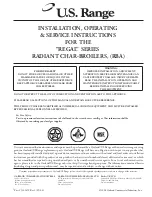
29
Installing a Vent
Installing a Vent
Warning
Improper venting of the boiler can result in excessive levels
of carbon monoxide, which can lead to severe personal injury
or death. This boiler must be vented in accordance with the
“Venting of Equipment“ section of the latest edition of the
ANSI Z223.1/NFPA 54 Natural Fuel Gas Code in the USA and/or
the “Venting systems and air supply for boilers“ section of the
latest version of the CAN/CGA B149.1 Natural Gas and Propane
Installation Code in Canada, as well as all applicable local
building codes and regulations.
Follow all instructions and guidelines when venting the boiler.
Venting should be performed only by a licensed professional.
The boiler must be properly vented to ensure a constant supply of
clean intake air and to ensure that exhaust air is properly removed
from living areas. When venting the boiler, follow these guidelines:
•
Do not install the boiler in areas with contaminated air (containing
a high level of dust, sawdust, sand, four aerosols, or any other such
airborne contaminants), as contaminants can cause operational
problems. The warranty does not cover damage caused by
contaminants in the installation area. If you must install the boiler
in an area with contaminated air, use direct venting to supply air
from outside the building. We recommend regular flter cleaning
and maintenance in these areas.
•
For best results, keep the venting system as short and straight as
possible.
•
Locate the boiler as close as possible to the vent termination.
•
Do not connect the boiler vent to a vent for any other gas boiler
or vent stack.
•
For horizontal runs, slope the horizontal section upward toward
the vent termination at a rate of 1/4" per foot (2% slope).
•
Create an airtight seal at each joint in the exhaust and intake air
pipes from the boiler collar to the vent termination.
•
To avoid moisture and frost build-up and to maintain clearances
to openings on adjacent homes, 45° elbows, 90° elbows, or tees
may be attached to the end of the termination vent pipe to direct
the exhaust fumes away from buildings, as long as the restrictions
on total allowable vent lengths, maximum number of elbows, and
distances to air intake are observed.
•
Do not store hazardous or fammable substances near the vent
termination.
•
If this boiler is to be installed in an area where snow is known to
accumulate, protect the vent termination from blockage.
•
Ensure that the vent termination is at least 12" (305mm) above
ground, or as required by local codes.
•
Support the vent pipe with hangers at regular intervals or as
required by local codes.
•
Exhaust and intake air pipes must be supported at least every 4
feet (1.2m).
•
The vent for this appliance shall not terminate over public
walkways; or near soft vents or crawl space vents or where
condensate or vapor could create a nuisance or hazard or cause
property damage; or where condensate or vapor could cause
damage or could be detrimental to the operation of regulators,
relief valves, or other equipment.
Vent Type
All boilers are prepared at the factory to be direct vent (sealed
combustion) boilers that draw all of their required combustion
required combustion air directly from outside the building. VESTA.
DS recommends direct air vent installations whenever possible
to avoid back drafting cold air through the boiler. VESTA.DS
recommends direct air vent installations when installing the boiler
in your attic to get fresh air into the boiler. If you cannot use a direct
vent, ensure that an ample supply of make-up air is available in the
installation location. VESTA.DS also recommends installing a new
vent system with this appliance. If reusing an existing vent system,
thoroughly inspect it for punctures, cracks, or blockages prior to
connecting it to the boiler. When using non-direct venting, must
provide two openings as specifed in the table on page 28.
Direct
The boiler uses 2" or 3" diameter exhaust and 2" or 3" diameter
intake air ducts. To ensure the draw of air directly from and exhaust
of air directly to the outside of the building, create an airtight seal
from the boiler collar to the vent termination.
Intake materials can be made of ABS, PVC, CPVC, PP, galvanized
steel, corrugated aluminum or any other similar materials. If you use
a corrugated material, ensure that there is not inadvertent crimping
of, or damage to, the intake air pipe.
When using direct venting, maintain the following venting
clearances, as required by ANSI Z21.10.3 and the National Fuel Gas
Code, ANSI Z223.1/NFPA 54, and CAN/CGA B149.1 Natural Gas and
Propane Installation Code.
To use direct venting for the boiler:
•
Install the 2" vent directly. Ensure the vent is properly seated.
•
To install the 3" vent, reducer (3" to 2") must be used.
•
Install the reducer (3" to 2") vertically. If installed horizontally,
water may stagnate.
2" PVC Pipe
3" PVC Pipe
3" Elbow
Reducer (3"
→
2")
2" Elbow
Condensation
pooling
Summary of Contents for VRC-100
Page 62: ...Memo ...
Page 63: ...Memo ...
















































